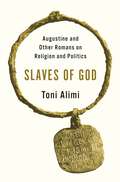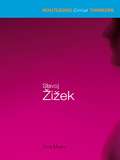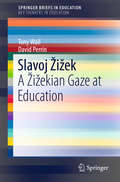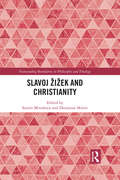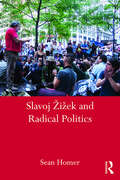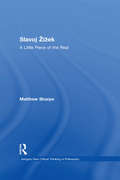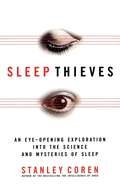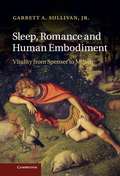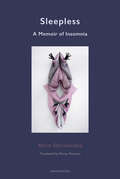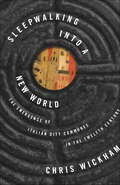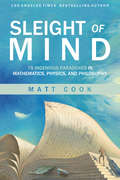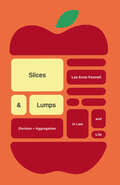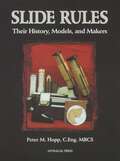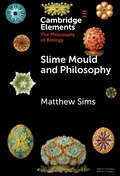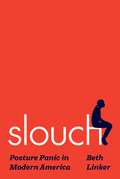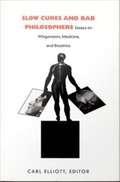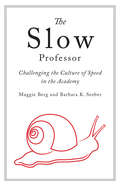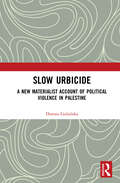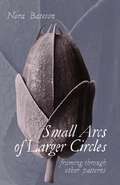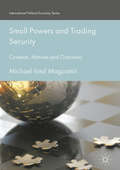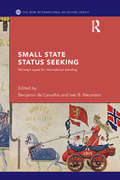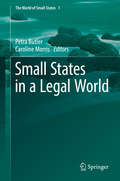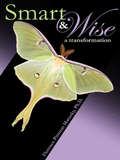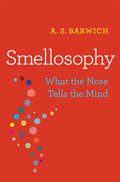- Table View
- List View
Slaves of God: Augustine and Other Romans on Religion and Politics
by Toni AlimiA provocative look at the central role of slavery in Augustine&’s religious, ethical, and political thoughtAugustine believed that slavery is permissible, but to understand why, we must situate him in his late antique Roman intellectual context. Slaves of God provides a major reassessment of this monumental figure in the Western religious and political tradition, tracing the remarkably close connections between Augustine&’s understanding of slavery and his broader thought.Augustine is most often read through the lens of Greek philosophy and the theology of Christian writers such as Paul and Ambrose, yet his debt to Roman thought is seldom appreciated. Toni Alimi reminds us that the author of Confessions and City of God was also a Roman citizen and argues that some of the thinkers who most significantly shaped his intellectual development were Romans such as Cicero, Seneca, Lactantius, and Varro—Romans who had much to say about slavery and its relationship to civic life. Alimi shows how Augustine, a keen and influential student of these figures, related chattel slavery and slavery to God, and sheds light on Augustinianism&’s complicity in Christianity&’s long entanglement with slavery.An illuminating work of scholarship, Slaves of God reveals how slavery was integral to Augustine&’s views about law, rule, accountability, and citizenship, and breaks new ground on the topic of slavery in late antique and medieval political thought.
Slavoj Zizek (Routledge Critical Thinkers)
by Tony MyersSlavoj Zizek is no ordinary philosopher. Approaching critical theory and psychoanalysis in a recklessly entertaining fashion, Zizek's critical eye alights upon a bewildering and exhilarating range of subjects, from the political apathy of contemporary life, to a joke about the man who thinks he's a chicken, from the ethicial heroism of Keanu Reeves in Speed, to what toilet designs reveal about the national psyche. Tony Myers provides a clear and engaging guide to Zizek's key ideas, explaining the main influences on Zizek's thought (most crucially his engagement with Lacanian psychoanalysis) using examples drawn from popular culture and everyday life. Myers outlines the key issues that Zizek's work has tackled, including: What is a Subject and why is it so important? The Imaginary, the Symbolic and the Real What is so terrible about Postmodernity? How can we distinguish reality from ideology? What is the relationship between men and women? Why is Racism always a fantasy? Slavoj Zizek is essential reading for anyone wanting to understand the thought of the critic whom Terry Eagleton has described as "the most formidably brilliant exponent of psychoanalysis, indeed of cultural theory in general, to have emerged in Europe for some decades.
Slavoj Žižek
by Tony Wall David PerrinŽižek demands we take a long, hard look at the painful reality of education in contemporary capitalist society, and to actively seek out its 'trouble in paradise': Why is it education is supposedly failing to meet the demands of our society? Why is it there are record levels of stress for teachers? Why is it there is a record level of complaints from our university students? How is it now possible to compare a higher education course with a vacuum cleaner, toaster or television? This book illuminates aspects of Žižek's ideas which sheds light into these modern challenges and tensions in education, and considers alternative ways forward. Though Žižek frustrates as much as he inspires with his own recipe of Lacan, Hegel and Marx, this book aims to give an entry route into Žižekian critique of education, a topic area he very rarely directly talks about.
Slavoj Žižek and Christianity (Transcending Boundaries in Philosophy and Theology)
by Sotiris Mitralexis Dionysios SklirisSlavoj Žižek’s critical engagement with Christian theology goes much further than his seminal The Fragile Absolute (2000), or his The Puppet and the Dwarf (2003), or even his discussion with noted theologian John Milbank in The Monstrosity of Christ (2009). His reading of Christianity, utilising his signature elements of Lacanian psychoanalysis and Hegelian philosophy with modern philosophical currents, can be seen as a genuinely original contribution to the philosophy of religion. This book focuses on these aspects of Žižek’s thought with either philosophy and cultural theory, or Christian theology, serving as starting points of enquiry. Written by a panel of international contributors, each chapter teases out various strands of Žižek’s thought concerning Christianity and religion and brings them into a wider conversation about the nature of faith. These essays show that far from being an outright rejection of Christian thought and intellectual heritage, Žižek’s work could be seen as a perverse affirmation thereof. Thus, what he has to say should be of direct interest to Christian theology itself. Touching on thinkers such as Badiou, Lacan, Chesterton and Schelling, this collection is a dynamic reading and re-reading of Žižek’s relationship to Christianity. As such, scholars of theology, the philosophy of religion and Žižek more generally will all find this book to be of great interest.
Slavoj Žižek and Radical Politics
by Sean HomerIn this book, Sean Homer addresses Slavoj Žižek’s work in a specific political conjuncture, his political interventions in the Balkans. The charge of inconsistency and contradiction is frequently levelled at Žižek’s politics, a charge he openly embraces in the name of "pragmatism." Homer argues that his interventions in the Balkans expose the dangers of this pragmatism for the renewal of the Leftist politics that he calls for. The book assesses Žižek’s political interventions in so far as they advance his self-proclaimed "ruthlessly radical" aims about changing the world. Homer argues the Balkans can be seen as Žižek’s symptom, that element which does not fit into the system, but speaks its truth and reveals what the system cannot acknowledge about itself. In Part II Homer explores Žižek’s radicalism through his critique of Alain Badiou, arguing that Badiou’s "affirmationism" provides a firmer grounding for the renewal of the left than Žižek’s negative gesture analyzed in Part I. What distinguishes Žižek from the majority of the contemporary Left today is his valorization of violence; Homer tackles this issue head-on in relation to political violence in Greece. Finally, Homer defends the utopian impulse on the radical left against its Lacanian critics.
Slavoj Žižek: A Little Piece of the Real (Ashgate New Critical Thinking in Philosophy)
by Matthew SharpeSlavoj Zizek has emerged as the pre-eminent European cultural theorist of the last decade and has been described as the ultimate Marxist/Lacanian cultural studies scholar. His large and growing body of work has generated considerable controversy, yet his texts are not structured as standard academic tomes. In Slavoj Zizek: A Little Piece of the Real, Matthew Sharpe undertakes the difficult task of drawing out an evolving argument from all of Zizek's texts from 1989 to 2001, and reads them as the bearers of a single theoretical project, providing an authoritative, reliable, clearly written and well-structured account of Zizek's demanding body of work. From an exposition of Zizek's social and philosophical critical theory the book moves to a critical analysis of Zizek's theoretical project and its political implications. Sharpe concludes by suggesting that Zizek's work, however, raises as many questions as it answers; questions both about Zizek's theoretical system and to the wider new Left in today's world.
Sleep Thieves: An Eye-opening Exploration Into The Science And Mysteries Of Sleep
by Stanley CorenThe A to ZZZ of sleep is offered by the bestselling author of The Intelligence of Dogs. In an engrossing blend of entertaining anecdotes and scientific data, bestselling author Stanley Coren explores the world of sleep and sleeplessness.
Sleep, Romance and Human Embodiment: Vitality from Spenser to Milton
by Garrett A. Sullivan Jr.Garrett Sullivan explores the changing impact of Aristotelian conceptions of vitality and humanness on sixteenth- and seventeenth-century literature before and after the rise of Descartes. In the Renaissance, Aristotle's tripartite soul is usually considered in relation to concepts of psychology and physiology. However, Sullivan argues that its significance is much greater, constituting a theory of vitality that simultaneously distinguishes man from, and connects him to, other forms of life. He contends that, in works such as Sidney's Old Arcadia, Shakespeare's Henry IV and Henry V, Spenser's Faerie Queene, Milton's Paradise Lost and Dryden's All for Love, the genres of epic and romance, whose operations are informed by Aristotle's theory, provide the raw materials for exploring different models of humanness; and that sleep is the vehicle for such exploration as it blurs distinctions among man, plant and animal.
Sleepless: A Memoir of Insomnia
by Marie DarrieussecqA restless inquiry into the cultural and psychic sources of insomnia by one of contemporary French literature&’s most elegant voices.Plagued by insomnia for twenty years, Marie Darrieussecq turns her attention to the causes, implications, and consequences of sleeplessness: a nocturnal suffering that culminates at 4 a.m. and then defines the next day. &“Insomniac mornings are dead mornings,&” she observes. Prevented from falling asleep by her dread of exhaustion the next day, Darrieussecq turns to hypnosis, psychoanalysis, alcohol, pills, and meditation. Her entrapment within this spiraling anguish prompts her inspired, ingenious search across literature, geopolitical history, psychoanalysis, and her own experience to better understand where insomnia comes from and what it might mean. There are those, she writes, in Rwanda, whose vivid memories of genocide leave them awake and transfixed by complete horror; there is the insomnia of the unhoused, who have nowhere to put their heads down. The hyperconnection of urban professional life transforms her bedroom from a haven to a dormant electrified node. Ranging between autobiography, clinical observation, and criticism, Sleepless is a graceful, inventive meditation by one of the most daring, inventive novelists writing today.
Sleepwalking into a New World: The Emergence of Italian City Communes in the Twelfth Century (The Lawrence Stone Lectures)
by Chris WickhamA bold new history of the rise of the medieval Italian communeAmid the disintegration of the Kingdom of Italy in the eleventh and twelfth centuries, a new form of collective government—the commune—arose in the cities of northern and central Italy. Sleepwalking into a New World takes a bold new look at how these autonomous city-states came about, and fundamentally alters our understanding of one of the most important political and cultural innovations of the medieval world.Chris Wickham provides richly textured portraits of three cities—Milan, Pisa, and Rome—and sets them against a vibrant backcloth of other towns. He argues that, in all but a few cases, the elites of these cities and towns developed one of the first nonmonarchical forms of government in medieval Europe, unaware that they were creating something altogether new. Wickham makes clear that the Italian city commune was by no means a democracy in the modern sense, but that it was so novel that outsiders did not know what to make of it. He describes how, as the old order unraveled, the communes emerged, governed by consular elites "chosen by the people," and subject to neither emperor nor king. They regularly fought each other, yet they grew organized and confident enough to ally together to defeat Frederick Barbarossa, the German emperor, at the Battle of Legnano in 1176.Sleepwalking into a New World reveals how the development of the autonomous city-state took place, which would in the end make possible the robust civic culture of the Renaissance.
Sleight of Mind: 75 Ingenious Paradoxes in Mathematics, Physics, and Philosophy (The\mit Press Ser.)
by Matt CookExploring more than seventy-five well-known paradoxes in mathematics, philosophy, physics, and the social sciences showing how reason and logic can dispel the illusion of contradiction.Paradox is a sophisticated kind of magic trick. A magician's purpose is to create the appearance of impossibility, to pull a rabbit from an empty hat. Yet paradox doesn't require tangibles, like rabbits or hats. Paradox works in the abstract, with words and concepts and symbols, to create the illusion of contradiction. There are no contradictions in reality, but there can appear to be. In Sleight of Mind, Matt Cook and a few collaborators dive deeply into more than 75 paradoxes in mathematics, physics, philosophy, and the social sciences. As each paradox is discussed and resolved, Cook helps readers discover the meaning of knowledge and the proper formation of concepts—and how reason can dispel the illusion of contradiction. The journey begins with “a most ingenious paradox” from Gilbert and Sullivan's Pirates of Penzance. Readers will then travel from Ancient Greece to cutting-edge laboratories, encounter infinity and its different sizes, and discover mathematical impossibilities inherent in elections. They will tackle conundrums in probability, induction, geometry, and game theory; perform “supertasks”; build apparent perpetual motion machines; meet twins living in different millennia; explore the strange quantum world—and much more.
Slices & Lumps: Division and Aggregation in Law and Life
by Lee Anne FennellHow things are divided up or pieced together matters. Half a bridge is of no use at all. Conversely, many things would do more good if they could be divided up differently: Perhaps you would prefer a job that involves a third less work and a third less pay or a car that materializes only when needed and is priced accordingly? Difficulties in “slicing” and “lumping” shape nearly every facet of how we live and work—and a great deal of law and policy as well. Lee Anne Fennell explores how both types of challenges—carving out useful slices and assembling useful lumps—surface in myriad contexts, from hot button issues like conservation and eminent domain to developments in the sharing economy to personal struggles over work, money, time, diet, and exercise. Yet the significance of configuration is often overlooked, leading to missed opportunities for improving our lives. With a technology-fueled entrepreneurial explosion underway that is dividing goods, services, and jobs in novel ways, and as urbanization and environmental threats raise the stakes for assembling resources and cooperation, this is an especially exciting and crucial time to confront questions of slicing and lumping. The future of the city, the workplace, the marketplace, and the environment all turn on matters of configuration, as do the prospects for more effective legal doctrines, for better management of finances and health, and more. This book reveals configuration’s power and potential—as a unifying concept and as a focus of public and private innovation.
Slide Rules: Their History, Models, and Makers
by Peter M. HoppIn the hopes of "preserving these delightful devices for future generations," this collector of slide rules covers everything one could possibly want to know about this crude form of analog computer: from its invention in the 17th century to manufacturers- retailers, 1850-1998, and the Oughtred Society for collectors. Includes a glossary with biographies, patent data, component specs, dating and valuing, care, historical milestones, and illustrations
Slime Mould and Philosophy (Elements in the Philosophy of Biology)
by Matthew SimsPhysarum polycephalum, also known more colloquially as 'the blob', 'acellular slime mould', or just 'slime mould', is a unicellular multinucleate protist that has continued to attract the interest of biologists over the past century because of its complex life cycle, unique physiology, morphology, and behaviour. More recently, attention has shifted to Physarum as a model organism for investigating putative cognitive capacities such as decision making, learning, and memory in organisms without nervous systems. The aim of this Element is to illustrate how Physarum can be used as a valuable tool for approaching various topics in the philosophy of biology. Physarum and its behaviour not only pose a challenge to some of the received views of biological processes but also, I shall argue, provide an opportunity to clarify and appropriately sharpen the concepts underlying such received views.
Slouch: Posture Panic in Modern America
by Beth LinkerThe strange and surprising history of the so-called epidemic of bad posture in modern America—from eugenics and posture pageants to today&’s promoters of &“paleo posture&”In 1995, a scandal erupted when the New York Times revealed that the Smithsonian possessed a century&’s worth of nude &“posture&” photos of college students. In this riveting history, Beth Linker tells why these photos were only a small part of the incredible story of twentieth-century America&’s largely forgotten posture panic—a decades-long episode in which it was widely accepted as scientific fact that Americans were suffering from an epidemic of bad posture, with potentially catastrophic health consequences. Tracing the rise and fall of this socially manufactured epidemic, Slouch also tells how this period continues to feed today&’s widespread anxieties about posture.In the early twentieth century, the eugenics movement and fears of disability gave slouching a new scientific relevance. Bad posture came to be seen as an individual health threat, an affront to conventional race hierarchies, and a sign of American decline. What followed were massive efforts to measure, track, and prevent slouching and, later, back pain—campaigns that reached schools, workplaces, and beyond, from the creation of the American Posture League to posture pageants. The popularity of posture-enhancing products, such as girdles and lumbar supports, exploded, as did new fitness programs focused on postural muscles, such as Pilates and modern yoga. By 1970, student protests largely brought an end to school posture exams and photos, but many efforts to fight bad posture continued, despite a lack of scientific evidence.A compelling history that mixes seriousness and humor, Slouch is a unique and provocative account of the unexpected origins of our largely unquestioned ideas about bad posture.
Slow Cures and Bad Philosophers: Essays on Wittgenstein, Medicine, and Bioethics
by Carl ElliottSlow Cures and Bad Philosophers uses insights from the philosophy of Ludwig Wittgenstein to rethink bioethics. Although Wittgenstein produced little formal writing on ethics, this volume shows that, in fact, ethical issues permeate the entirety of his work. The scholars whom Carl Elliott has assembled in this volume pay particular attention to Wittgenstein's concern with the thick context of moral problems, his suspicion of theory, and his belief in description as the real aim of philosophy. Their aim is not to examine Wittgenstein's personal moral convictions but rather to explore how a deep engagement with his work can illuminate some of the problems that medicine and biological science present. As Elliott explains in his introduction, Wittgenstein's philosophy runs against the grain of most contemporary bioethics scholarship, which all too often ignores the context in which moral problems are situated and pays little attention to narrative, ethnography, and clinical case studies in rendering bioethical judgments. Such anonymous, impersonal, rule-writing directives in which health care workers are advised how to behave is what this volume intends to counteract. Instead, contributors stress the value of focusing on the concrete particulars of moral problems and write in the spirit of Wittgenstein's belief that philosophy should be useful. Specific topics include the concept of "good dying," the nature of clinical decision making, the treatment of neurologically damaged patients, the moral treatment of animals, and the challenges of moral particularism. Inspired by a philosopher who deplored "professional philosophy," this work brings some startling insights and clarifications to contemporary ethical problems posed by the realities of modern medicine. Contributors. Larry Churchill, David DeGrazia, Cora Diamond, James Edwards, Carl Elliott, Grant Gillett, Paul Johnston, Margaret Olivia Little, James Lindemann Nelson, Knut Erik Tranoy
Slow Professor: Challenging the Culture of Speed in the Academy
by Maggie Berg Barbara SeeberIf there is one sector of society that should be cultivating deep thought in itself and others, it is academia. Yet the corporatisation of the contemporary university has sped up the clock, demanding increased speed and efficiency from faculty regardless of the consequences for education and scholarship.In The Slow Professor, Maggie Berg and Barbara K. Seeber discuss how adopting the principles of the Slow movement in academic life can counter this erosion of humanistic education. Focusing on the individual faculty member and his or her own professional practice, Berg and Seeber present both an analysis of the culture of speed in the academy and ways of alleviating stress while improving teaching, research, and collegiality. The Slow Professor will be a must-read for anyone in academia concerned about the frantic pace of contemporary university life.
Slow Urbicide: A New Materialist Account of Political Violence in Palestine
by Dorota GolańskaThe book presents a new materialist understanding of acts of deliberate destruction of the built environment and, specifically, of the politics of aggressive spatial containment and regularization of urbanity employed within the conflict in Israel/Palestine. Building on recent scholarship on slow violence and urbicidal policies, it discusses the different dimensions of the violence against the urban space, as well as exposes the complex material-semiotic character of the urban territory and of its destruction. By referring to the concepts of “ethno-territoriality” and “the right to the city,” the book aims to generate an enhanced understanding of problems situated at the overlap of urban studies and investigations of state-sponsored violence, focusing specifically on issues related to urban warfare. Adopting a new materialist perspective, the book is a searing examination of political violence in our times. The volume will be of great interest to scholars and researchers of political science, international relations, cultural studies, and urban studies. It will also appeal to NGO professionals and activists across the world.
Small Arcs of Larger Circles: Framing through Other Patterns
by Nora BatesonBuilding on Gregory Bateson's famous book Towards an Ecology of Mind and her own film on the subject, Nora Bateson here updates our thinking on systems and ecosystems, applying her own insights and those of her team at IBI to education, organisations, complexity, academia, and the way that society organizes itself.
Small Powers and Trading Security
by Michael Intal MagcamitThis book examines why and how small powers link their security interests and trade agendas, and how security threats influence the facilitation and outcome of their trade activities. In doing so, it analyses the increasingly complex connections between trade and security, demonstrating how these linkages affect the overall security of four small but important states in East Asia. Focusing on the role of high levels of internal and external insecurities, marginal geo-economic size and peripheral geopolitical position, and multidimensional and multidirectional security contexts and threats, the author concludes that for every security enhancement that a linkage creates a consequent security risk is generated. In other words, Taiwan, Singapore, Malaysia, and the Philippines are effectively trading their security. This innovative book will appeal to political scientists, economists, and security and trade experts.
Small State Status Seeking: Norway's Quest for International Standing (New International Relations)
by Iver B Neumann Benjamin De CarvalhoStatus-seeking is an important aspect of the foreign policies of a number of small states, but one that has been rarely studied. This book aims to contribute to our understanding not only of status-seeking, by coming at that question from a new angle, that of a small state, but also to our understanding of foreign policy, by discussing the importance of status for foreign policy overall. If status is a hierarchy, then it is important to focus not just on the highest-ranking powers, but also those at lower levels. As the distribution of power is becoming more diffuse, the role of small and medium powers becomes more significant than it was during the Cold war. The book chapters go beyond familiar explications of "soft power" or conflict resolution to highlight new aspects of Norway’s foreign policy, including contributions to national defense, global warming, and management of Arctic resources. This book will be of interest to students and scholars in areas including US Foreign Policy, International Relations and European Politics.
Small States in a Legal World
by Caroline Morris Petra ButlerThis book is a unique collection of high quality articles analysing legal issues with particular regard to small states. The small states of the world differ considerably in their geography, history, political structures, legal systems and wealth. Nevertheless, because of their size, small states face a set of common challenges including vulnerability to external economic impacts such as changing trade regimes and limited ability to diversify economic activity; limited public and private sector capacity, including the legal and judicial infrastructure; a need for regional co-operation; a vulnerability to environmental changes as well as a limited ability to engage with supranational bodies and the forces of globalisation. This is the first volume of an exciting and unique new series, The World of Small States. In this work, legal experts from small jurisdictions and those with a particular interest in legal issues facing small states explore inter alia ethics in small jurisdictions, legal education and the profession in small states, the challenges facing small states with mixed legal systems, the constitutional arrangements in small states, small states as tax havens, and intellectual property and competition law issues.
Smart & Wise: A Transformation
by Florence Pittman MatuskyFlorence Matusky proposes that K-12 public education's primary focus on one hemisphere only (the left-brain) - to be test smart,not wise - produces students whose impoverished, "approved" knowledge is not for understanding self,others,or how to live,but for programming them with by-the-book,academic knowledge then reducing them to numbers.The rationale for flourish or perish ensures failures and dropouts; fosters poverty,crime,violence,addictions,greed,or selfishness;and jeopardizes two of America's Four Freedoms (freedom from fear and want).No one comes into this world and to school with a clean slate. We are born self-centered to get our survival needs met and with inherited and experiential embedded data from conception onward.All children and adults need to express their significance. When children experience being loved,respected, and their embedded true life stories - which are played out as behavior,appearance,and capacity to learn in school - are heard, understood, and accepted, then they learn to love, respect, and accept themselves and others "as is." Released from ego deficits and negativity,they are present to their full human intelligence.When the invisible curriculum(self-awareness, humane redevelopment, emotional resilience, virtues, and character) is not taught and modeled at home and in K-12 public schools,children's uneducated egos and passion and/or lack of meaning and respect override cognition,creating anti-social acts and unsafe societies. As adults, many seek significance outside themselves: power-over people,wealth, and/or the world's stage, creating wars, economic bubbles, income inequality,and declining human qualities and inner lives.Our societal ills are reflections of The Western Intellectual Tradition's legacy. Smart & Wise offers reasons for and solutions to America's quantitative, unequal public schools so students may rise to their higher faculties and excel in math,reading,science,innovation,communications,and relationships.
Smart Citizens, Smarter State: The Technologies of Expertise and the Future of Governing
by Beth Simone NoveckGovernments make too little use of the skills and experience of citizens. New tools--what Beth Simone Noveck calls technologies of expertise--are making it possible to match citizen expertise to the demand for it in government. She offers a vision of participatory democracy rooted not in voting or crowdsourcing but in people's knowledge and know-how.
Smellosophy: What the Nose Tells the Mind
by A. S. BarwichA pioneering exploration of olfaction that upsets settled notions of how the brain translates sensory information. Decades of cognition research have shown that external stimuli “spark” neural patterns in particular regions of the brain. This has fostered a view of the brain as a space that we can map: here the brain responds to faces, there it perceives a sensation in your left hand. But it turns out that the sense of smell—only recently attracting broader attention in neuroscience—doesn’t work this way. A. S. Barwich asks a deceptively simple question: What does the nose tell the brain, and how does the brain understand it? Barwich interviews experts in neuroscience, psychology, chemistry, and perfumery in an effort to understand the biological mechanics and myriad meanings of odors. She argues that it is time to stop recycling ideas based on the paradigm of vision for the olfactory system. Scents are often fickle and boundless in comparison with visual images, and they do not line up with well-defined neural regions. Although olfaction remains a puzzle, Barwich proposes that what we know suggests the brain acts not only like a map but also as a measuring device, one that senses and processes simple and complex odors. Accounting for the sense of smell upsets theories of perception philosophers have developed. In their place, Smellosophy articulates a new model for understanding how the brain represents sensory information.
